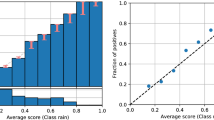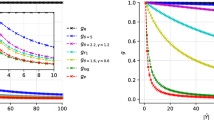Abstract
This paper provides new insight into maximizing F1 measures in the context of binary classification and also in the context of multilabel classification. The harmonic mean of precision and recall, the F1 measure is widely used to evaluate the success of a binary classifier when one class is rare. Micro average, macro average, and per instance average F1 measures are used in multilabel classification. For any classifier that produces a real-valued output, we derive the relationship between the best achievable F1 value and the decision-making threshold that achieves this optimum. As a special case, if the classifier outputs are well-calibrated conditional probabilities, then the optimal threshold is half the optimal F1 value. As another special case, if the classifier is completely uninformative, then the optimal behavior is to classify all examples as positive. When the actual prevalence of positive examples is low, this behavior can be undesirable. As a case study, we discuss the results, which can be surprising, of maximizing F1 when predicting 26,853 labels for Medline documents.
Chapter PDF
Similar content being viewed by others
Keywords
References
Akay, M.F.: Support vector machines combined with feature selection for breast cancer diagnosis. Expert Systems with Applications 36(2), 3240–3247 (2009)
Capen, E.C., Clapp, R.V., Campbell, W.M.: Competitive bidding in high-risk situations. Journal of Petroleum Technology 23(6), 641–653 (1971)
Cover, T.M., Thomas, J.A.: Elements of information theory. John Wiley & Sons (2012)
del Coz, J.J., Diez, J., Bahamonde, A.: Learning nondeterministic classifiers. Journal of Machine Learning Research 10, 2273–2293 (2009)
Dembczynski, K., Kotłowski, W., Jachnik, A., Waegeman, W., Hüllermeier, E.: Optimizing the F-measure in multi-label classification: Plug-in rule approach versus structured loss minimization. In: ICML (2013)
Dembczyński, K., Waegeman, W., Cheng, W., Hüllermeier, E.: An exact algorithm for F-measure maximization. In: Neural Information Processing Systems (2011)
Elkan, C.: The foundations of cost-sensitive learning. In: International Joint Conference on Artificial Intelligence, pp. 973–978 (2001)
Jansche, M.: A maximum expected utility framework for binary sequence labeling. In: Annual Meeting of the Association for Computational Linguistics, p. 736 (2007)
Lewis, D.D.: Evaluating and optimizing autonomous text classification systems. In: Proceedings of the 18th Annual International ACM SIGIR Conference on Research and Development in Information Retrieval, pp. 246–254. ACM (1995)
Madsen, R., Kauchak, D., Elkan, C.: Modeling word burstiness using the Dirichlet distribution. In: Proceedings of the International Conference on Machine Learning (ICML), pp. 545–552 (August 2005)
Manning, C., Raghavan, P., Schütze, H.: Introduction to information retrieval, vol. 1. Cambridge University Press (2008)
Menon, A., Jiang, X., Vembu, S., Elkan, C., Ohno-Machado, L.: Predicting accurate probabilities with a ranking loss. In: Proceedings of the International Conference on Machine Learning (ICML) (June 2012)
Mozer, M.C., Dodier, R.H., Colagrosso, M.D., Guerra-Salcedo, C., Wolniewicz, R.H.: Prodding the ROC curve: Constrained optimization of classifier performance. In: NIPS, pp. 1409–1415 (2001)
Musicant, D.R., Kumar, V., Ozgur, A., et al.: Optimizing F-measure with support vector machines. In: FLAIRS Conference, pp. 356–360 (2003)
Sokolova, M., Lapalme, G.: A systematic analysis of performance measures for classification tasks. Information Processing and Management 45, 427–437 (2009)
Suzuki, J., McDermott, E., Isozaki, H.: Training conditional random fields with multivariate evaluation measures. In: Proceedings of the 21st International Conference on Computational Linguistics and the 44th Annual Meeting of the Association for Computational Linguistics, pp. 217–224. Association for Computational Linguistics (2006)
Tan, S.: Neighbor-weighted k-nearest neighbor for unbalanced text corpus. Expert Systems with Applications 28, 667–671 (2005)
Tsoumakas, G., Katakis, I.: Multi-label classification: An overview. International Journal of Data Warehousing and Mining 3(3), 1–13 (2007)
Ye, N., Chai, K.M., Lee, W.S., Chieu, H.L.: Optimizing F-measures: A tale of two approaches. In: Proceedings of the International Conference on Machine Learning (2012)
Zhao, M.J., Edakunni, N., Pocock, A., Brown, G.: Beyond Fano’s inequality: Bounds on the optimal F-score, BER, and cost-sensitive risk and their implications. Journal of Machine Learning Research 14(1), 1033–1090 (2013)
Author information
Authors and Affiliations
Editor information
Editors and Affiliations
Rights and permissions
Copyright information
© 2014 Springer-Verlag Berlin Heidelberg
About this paper
Cite this paper
Lipton, Z.C., Elkan, C., Naryanaswamy, B. (2014). Optimal Thresholding of Classifiers to Maximize F1 Measure. In: Calders, T., Esposito, F., Hüllermeier, E., Meo, R. (eds) Machine Learning and Knowledge Discovery in Databases. ECML PKDD 2014. Lecture Notes in Computer Science(), vol 8725. Springer, Berlin, Heidelberg. https://doi.org/10.1007/978-3-662-44851-9_15
Download citation
DOI: https://doi.org/10.1007/978-3-662-44851-9_15
Publisher Name: Springer, Berlin, Heidelberg
Print ISBN: 978-3-662-44850-2
Online ISBN: 978-3-662-44851-9
eBook Packages: Computer ScienceComputer Science (R0)




